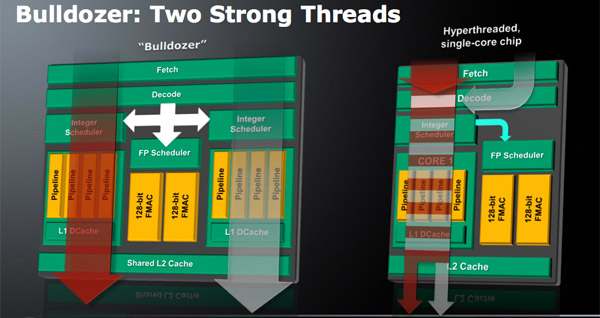AMD Discloses Bobcat & Bulldozer Architectures at Hot Chips 2010
by Anand Lal Shimpi on August 24, 2010 1:33 AM ESTBulldozer
AMD already gave us a good amount of detail on Bulldozer earlier this year. We’ll start with a quick refresher.
With Nehalem, Intel moved to a more modular design process that would allow it the ability to quickly configure different versions of the chip to hit various markets. With Bulldozer, AMD is doing the same.
The basic building block is the Bulldozer module. AMD calls this a dual-core module because it has two independent integer cores and a single shared floating point core that can service instructions from two independent threads. The two thread machine is larger than a single core but smaller than two cores with straight duplication of resources.

All else being the same, it should give you more threaded performance than a single SMT (Hyper Threaded) core but less than two dedicated cores. The savings are obviously on the die side. AMD tells us that the second integer core increases the Bulldozer module die by around 12%, despite significantly increasing performance in threaded integer applications.

Processors may implement anywhere from one to four Bulldozer modules and will be referred to as 2 to 8 core CPUs. Each core appears to the OS as a logical processor similar to what you get with Hyper Threading. A CPU with four Bulldozer modules would appear as an 8-threaded processor under Task Manager in Windows.
AMD argues that the Bulldozer module is ideal provisioning of hardware. With SMT (Hyper Threading) you force too much into a single core, while with traditional multicore you often waste hardware as any idle resources are duplicated across the chip.

Bulldozer CPUs will be AMD’s first 32nm processors manufactured at GlobalFoundries.
The new details today are about everything inside of the Bulldozer module.










76 Comments
View All Comments
SuperiorSpecimen - Tuesday, August 24, 2010 - link
Let's see some competition outside of the price game!mrmojo1 - Tuesday, August 24, 2010 - link
Awesome article, can't wait to see their release :) Should be very interesting!crawmm - Tuesday, August 24, 2010 - link
I drooled on my laptop reading this. Thank you, Anand. Good overview. And fun reading after a day of tedious (and mindless) work.lothar98 - Tuesday, August 24, 2010 - link
"In many ways the architecture looks to be on-par with what Intel has done with Nehalem/Westmere."I truly hope that this does not end up to be how things roll out. It has been far too long since we have seen good competition throughout the range of consumer CPU lineup. Currently we have options and competition in the mid-low end giving us exceptional bang for our buck. While one would never say you can get the best bang for your buck in the mid or high end everyone can still appreciate having options as well as getting value.
Freddo - Tuesday, August 24, 2010 - link
Bobcat seems very interesting to me, I hope it won't take long until we see a good netbook with it, with good build quality (metal, no plastic toy), a HDMI port and 2GB RAM.Mike1111 - Tuesday, August 24, 2010 - link
I'm wondering: what about AMD powered notebooks? And I don't mean netbooks or CULV notebooks. Looks like bulldozer won't come to notebooks until 2012, which would mean that AMD would most likely have to compete with Intel's 22nm Sandy Bridge successor, Ivy Bridge.Penti - Tuesday, August 24, 2010 - link
Llano APU, it's briefly mentioned. It's where we're at. Basically K10-based 4-core with integrated DX11 GPU. Better then today but not much of a competition.mino - Tuesday, August 24, 2010 - link
The GPU in the is supposed to be at least 5x the speed of current IGP performance.Basically you get a "discrete" GPU for a price of IGP ...
MonkeyPaw - Tuesday, August 24, 2010 - link
I can see Bobcat scaling upward in notebooks. It's multi-core capable, and is a fully-functional CPU. A quad core Bobcat with better-than-Intel graphics should be a very fulfilling product for notebooks in the mid-range, while providing good battery life (thank you, power gating). Anything above that could be handled by low-voltage Bulldozers as a premium offering. To me, that seems like a better solution than Intel's, where the Atom to Core increase is so severe.Kiijibari - Tuesday, August 24, 2010 - link
Ehh guys ...MMX is depracated in 64bit mode together with x87 and 3Dnow!:
--------
The x87, MMX, and 3DNow! instruction sets are deprecated in 64-bit modes. The instructions sets are still present for backward compatibility for 32-bit mode; however, to avoid compatibility issues in the future, their use in current and future projects is discouraged.
--------
http://msdn.microsoft.com/en-us/library/ee418798%2...
Why on Earth should AMD build in 2 special MMX pipes in a brand new µarchitecture ?
AMD just announced that they got rid of 3Dnow!, MMX pipes make no sense at all.
You probably mean XOP, dont you ?